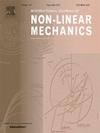任意初始应力参考点和无应力参考点的响应
IF 2.8
3区 工程技术
Q2 MECHANICS
International Journal of Non-Linear Mechanics
Pub Date : 2025-03-08
DOI:10.1016/j.ijnonlinmec.2025.105070
引用次数: 0
摘要
本文章由计算机程序翻译,如有差异,请以英文原文为准。
Responses of any arbitrary initially stressed reference and the stress-free reference
The constitutive relation for an initially stressed reference is often determined by using the response of a virtual stress-free reference. However, identifying the constitutive relation of the original stress-free body can be challenging without conducting destructive tests. This paper presents three approaches for determining the response of a stress-free reference—or any arbitrary initially stressed reference—when the response of a particular initially stressed reference is known. Unlike standard practice, these approaches of changing reference configurations do not begin with a known stress-free state. The first and third approaches directly derive the constitutive relations of one stressed reference from another. The first approach is applicable to a specific constitutive relation of the known initially stressed state, while the third approach extends the first and is applicable to any constitutive form. The second approach uses any general response of a given stressed reference to identify the stress-free material. The response of the stress-free material is further analyzed and processed to determine the response of any stressed reference. We observe that even when the known initially stressed state is Green elastic, the arbitrarily stressed or stress-free references may exhibit implicit elasticity. Several explicit constitutive relations are also exemplified. One of the examples utilizes the invariants of Seth’s generalized strain measures. For experimental validation of this model, we transform the Treloar data to various initially stressed references. Model parameters corresponding to a specific stressed state are optimized by corroborating the model against the Treloar data associated with that reference. These optimized parameters are then used to determine the constitutive relations for the stress-free and other stressed reference configurations. The resulting constitutive relations for various references show identical alignment with the corresponding Treloar data, thereby validating the present approaches for changing the reference configuration. It is demonstrated that the developed models satisfy all restrictions related to the change of references. Furthermore, we develop universal relations for stress-free isotropic implicit elastic materials.
求助全文
通过发布文献求助,成功后即可免费获取论文全文。
去求助
来源期刊
CiteScore
5.50
自引率
9.40%
发文量
192
审稿时长
67 days
期刊介绍:
The International Journal of Non-Linear Mechanics provides a specific medium for dissemination of high-quality research results in the various areas of theoretical, applied, and experimental mechanics of solids, fluids, structures, and systems where the phenomena are inherently non-linear.
The journal brings together original results in non-linear problems in elasticity, plasticity, dynamics, vibrations, wave-propagation, rheology, fluid-structure interaction systems, stability, biomechanics, micro- and nano-structures, materials, metamaterials, and in other diverse areas.
Papers may be analytical, computational or experimental in nature. Treatments of non-linear differential equations wherein solutions and properties of solutions are emphasized but physical aspects are not adequately relevant, will not be considered for possible publication. Both deterministic and stochastic approaches are fostered. Contributions pertaining to both established and emerging fields are encouraged.

 求助内容:
求助内容: 应助结果提醒方式:
应助结果提醒方式:


